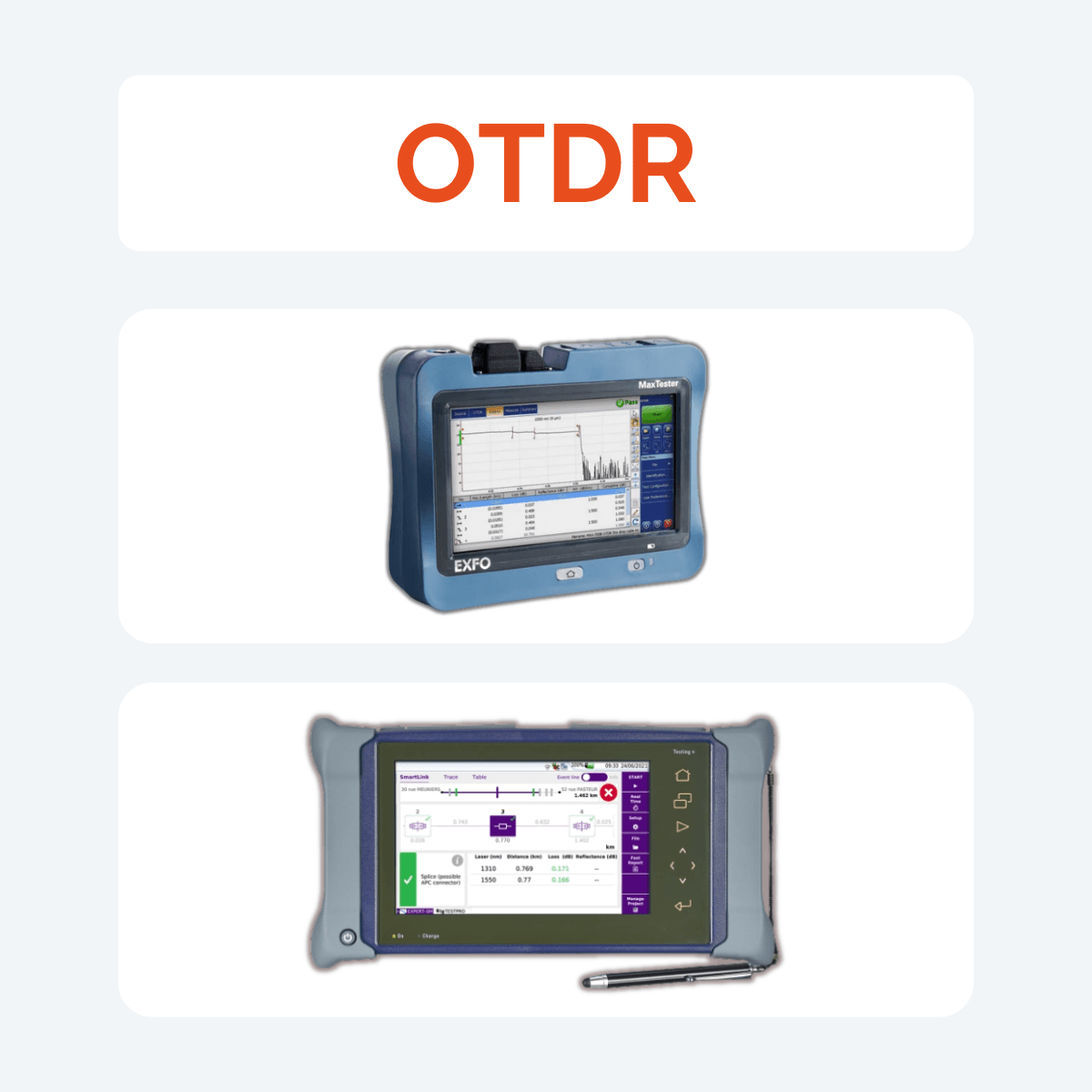Choosing the right OTDR (Optical Time-Domain Reflectometer) can make or break your fiber testing workflow. Whether you’re certifying a new enterprise backbone, diagnosing faults in a data center, or auditing a live FTTH network, the right OTDR ensures accurate diagnostics, faster work, and fewer surprises in the field.
But not all OTDRs are the same. Let’s explore what makes a good OTDR, how to select the right one for your project, and why renting the right model from trusted brands like Viavi, EXFO, AEM or Fluke can be a smart move.
First: define your application for your OTDR
Before you choose a model, define your testing environment. OTDRs are used far beyond enterprise networks:
- Enterprise backbones
- Data centers
- FTTH deployments
- Carrier networks
- Campus-wide infrastructures
- Industrial or rail networks
Each environment has its own demands in terms of resolution, distance, and event density.
Start by identifying:
- Fiber type (singlemode or multimode)
- Typical link length
- Density of connectors/splices
- Required precision and documentation level
- Budget (or rental vs. purchase preference)
What an OTDR actually measures
An OTDR works by sending laser pulses through a fiber and measuring the light that’s scattered or reflected back. From that, it generates a “trace” that maps out splices, bends, connectors, and breaks — allowing the technician to quantify:
- Total link loss
- Distance to faults or events
- Optical return loss (ORL)
- Attenuation (dB/km)
Because OTDRs only require access from one end of the fiber, they are ideal for situations where full-duplex testing is not practical.
Key specifications to consider when choosing your OTDR
1. Wavelengths supported
Most enterprise applications require testing at 1310 nm and 1550 nm for singlemode fiber. For multimode fiber, common wavelengths are 850 nm and 1300 nm. For advanced diagnostics or live fiber monitoring, 1625 nm or 1650 nm are also used. These out-of-band wavelengths help detect macrobends or service-affecting events without interrupting service.
2. Dynamic range
This determines how far the OTDR can see into the fiber. A higher dynamic range is crucial for long or lossy links. A typical enterprise application will do well with 35–45 dB.
✅ Rule of thumb: choose an OTDR with a dynamic range 5–8 dB higher than your expected total link loss.
3. Event and attenuation dead zones
Dead zones are blind spots caused by reflections (Fresnel reflection) — short dead zones let you detect events that are very close together. Critical in high-density environments like data centers.
- Event dead zone: Distance needed to detect a second event
- Attenuation dead zone: Distance needed to measure the second event’s loss
4. Pulse width
Short pulses = short dead zones but lower reach.
Long pulses = longer reach but less resolution.
Many OTDRs today offer auto pulse width selection for optimal results.
5. Dual-wavelength testing
To identify fusion splices vs. macrobends, dual-wavelength testing is required. Macrobends show higher loss at longer wavelengths (e.g., 1550 vs 1310), while fusion splices remain stable.
6. Sampling resolution
The higher the sampling resolution, the better the OTDR can pinpoint the exact location of faults. High-resolution OTDRs can differentiate events spaced just centimeters apart.
Launch cables: don’t forget them
OTDRs are often used with launch cables (also called fiber rings). These are essential for:
- Measuring the loss of the first connector
- Allowing the OTDR to stabilize before the link under test
- Enabling accurate bi-directional testing
👉 See RentalTec’s launch cables:
🔗 https://rentaltec.com/manufacturer/fibrain/
What is Bi-directional OTDR testing?
Standard OTDR testing runs from one end. But in some cases — especially when high precision is required — bi-directional testing is advised.
Bi-directional (or “bidir”) testing sends signals from both ends of the fiber and averages the results. This provides more accurate loss and length values, especially in fibers with multiple splices or varying connector quality.
Which OTDR should you rent?
RentalTec offers a wide range of OTDRs from Viavi, EXFO, AEM and Fluke — all field-tested and calibrated. Here’s a snapshot of top models for different applications:
Viavi Solutions
EXFO
Fluke Networks
AEM
All units come pre-calibrated, and our team is available for support if needed.
Conclusion: don’t let fiber testing slow you down
OTDRs are essential tools for any fiber professional. But choosing the right one — with the right wavelengths, resolution, dynamic range and pulse width — can drastically improve your workflow and accuracy.
Whether you’re testing a 10-meter jumper in a data center or a 120 km link in a telco backbone, RentalTec has the tools and expertise to support your needs.
Ready to rent your OTDR?
Explore our full range of OTDRs here:
🔗 https://rentaltec.com/product-category/telecom/fibre-installation-maintenance/otdrs/
Need help selecting the right model? Our technical team is here to assist — no fluff, just real support.


